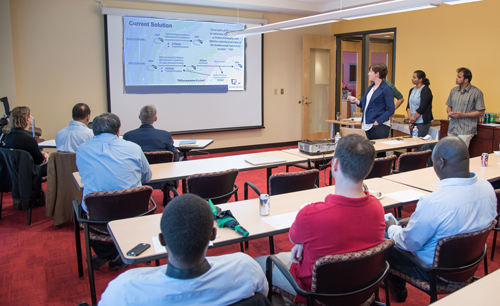New UMB Course Combines Business & Science
“Twelve weeks ago, these projects were literally just ideas,” said Rana Quraishi, PhD, director of new ventures in the Office of Research and Development at the University of Maryland, Baltimore (UMB). Quraishi was welcoming students, intellectual property experts, and scientists to the final meeting of UMB’s first-ever course in developing and pitching a biotechnology business concept, called CIPP 980.
A group of 12 UMB students from various schools and disciplines were about to pitch their business plans to a panel of experts, with one group “winning” a hypothetical investment. At the beginning of the semester, as Quraishi pointed out, they began the class empty-handed. Now they presented ideas, proposals for winning approval from the U.S. Food and Drug Administration, and detailed timelines and cost estimates for their hypothetical new technologies.
“There was tremendous interest from students from all the science-related graduate schools, from postdoctoral fellows, and from medical students and fellows,” Quraishi said of the class’s inception. “It was inspiring to see the level of demand.”

Students in Rana Quraishi's CIPP 980 entrepreneurship in biotechnology course listen to one another's final presentations.
The idea is to open students’ minds to the many career possibilities available in their chosen fields of study, said James L. Hughes, MBA, chief enterprise and economic development officer and vice president at UMB, and director of UM Ventures. The biotechnology industry is a major driver of the Maryland economy and a viable option for students looking for fulfilling careers in science. But typical science curricula don’t include information on entrepreneurship, Hughes said.
“This university, like most, is not geared toward careers in industry,” Hughes said. “But we’d like to do more.”
Quraishi’s course is part of UMB’s commitment to that end. Students learned about vetting scientific ideas for competition and for intellectual property rights. They studied the federal regulatory process and associated costs and time frames. They learned how to approach investors and how to develop a solid pitch based on key business principles. Students even learned “strategies for exiting the product,” Quraishi said, “for example, selling to a pharmaceutical or device company once you have developed the product to a point where its value is obvious.”
The students learned from those who have already walked the path of biotechnology commercialization. Quraishi hosted guest speakers such as Marco Chacon, PhD, founder and chair of University of Maryland BioPark tenant Paragon Bioservices; Shari Corin, JD, PhD, an accomplished patent attorney with UM Ventures; and Neil Davis, director of entrepreneurial development at TEDCO (the Maryland Technology Development Corporation).
The speakers also included two of the experts who would judge the final projects: Phil Robilotto, DO, MBA, chief commercialization officer for UM Ventures and assistant vice president and head of the Office of Technology Transfer at UMB; and Darryl Carter, MD, co-founder of biotechnology firm Nora Therapeutics. The third “judge” was Lindsay Czuba, a PhD candidate at the University of Maryland School of Pharmacy and a member of the President’s Fellows.
“One thing I enjoyed most was our guest speakers,” said David Kurland, a University of Maryland School of Medicine MD/PhD student. “Having real-life people come as opposed to the didactic format was phenomenal.”
At their presentations in early May, the students had come a long way from “just ideas.” Their ideas were hypothetical, developed to serve as a basis for the business plans they would pitch.
Group member Brian Johnson, a third-year PhD student in the Department of Physical Therapy and Rehabilitation Sciences, says the class – and his time at UMB – has opened his mind to career possibilities. He had never considered the option of being a clinician and researcher and an entrepreneur all at once.
“Before starting at UMB, I didn’t really know you could do both,” said Johnson. “I’m inspired. Everyone’s been very supportive. It’s a great environment to be creative.”
After their presentations, Robilotto said all three groups touched on the key elements of a business pitch, with some better than others.
Robilotto had some advice for the students, should they ever be in such a position in the future: stay on message. “You tell somebody what you tell them, then you tell them. Then you tell them what you just told them,” he said.



